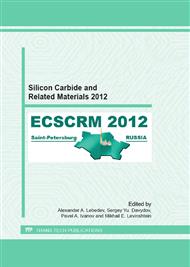p.69
p.73
p.77
p.81
p.85
p.91
p.95
p.99
p.103
Growth of Low-Defect SiC and AlN Crystals in Refractory Metal Crucibles
Abstract:
Recently the wide bandgap semiconductors, silicon carbide (SiC) and aluminum nitride (AlN), have acquired increased importance due to the unique properties that make them applicable to a variety of rapidly-emerging, diverse technologies. In order to meet the challenges posed by these applications the materials need to be manufactured with the highest possible quality, both structural and chemical, at increasingly lower cost. This requirement places rather extreme constraints on the crystal growth as the simultaneous goals of high quality and low cost are generally incompatible. Refractory metal carbide technology, particularly, tantalum carbide (TaC), was originally developed for application in highly corrosive and reactive environments. The SiC group of Prof Yuri A Vodakov (for example, [1]) at Karmon Ltd in St Petersburg, Russia was the first to study and utilize the properties of refractory metal carbides, first for the growth of SiC and later for the growth of AlN. We discuss how the refractory metal carbides can answer many of the problems of growing SiC and AlN in a relatively simple and low cost manner.
Info:
Periodical:
Pages:
85-90
Citation:
Online since:
January 2013
Price:
Сopyright:
© 2013 Trans Tech Publications Ltd. All Rights Reserved
Share:
Citation:


